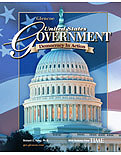
U. S. Government: Democracy In ActionChapter 9: Presidential LeadershipChapter OverviewsThe president of the United States is an extremely powerful person. As the commander-in-chief of our armed forces, the president has the authority to direct our nation's military. Chapter 9 discusses the changing powers of the president over time and the leadership qualities important to the success of the president. Section 1 deals with the various powers of the president and how they have evolved. Working within the confines of the Constitution, presidents have used their inherent powers to meet the needs of the changing nation. For example, Roosevelt used the power of the presidency to expand the federal government's role in a time of economic crisis by creating additional government programs and services. Section 2 introduces the roles of the president as they are defined in the Constitution and the additional roles that have been added. Key terms such as executive order, impoundment, reprieve, pardon, amnesty, patronage, treaty, and executive agreement are used to show how the president fulfills these roles. Section 3 discusses the various styles of leadership that have made presidents successful. A few of the positive leadership qualities include the ability to communicate, an openness to new ideas, and the ability to compromise. The ability to communicate is especially important for the president to explain policies clearly and to rally support from the public. |  |















